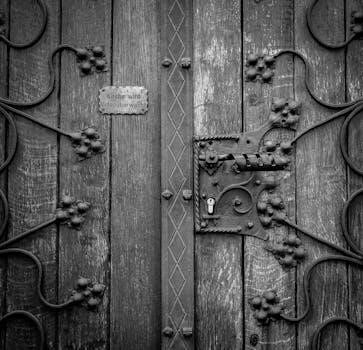Sliding Gate Detail Drawings⁚ An Overview
This section introduces the concept of detailed drawings for sliding gates, emphasizing their importance in planning and construction. These drawings provide essential specifications, including dimensions and materials. They are available in PDF format for easy access and use.
Types of Sliding Gates
Sliding gates come in various configurations, each suited for different applications and spatial requirements. Sectional sliding gates, a notable type, are ideal where space is limited and high security is necessary, presenting an alternative to standard swing gates. Unlike swing gates, which can be easily pushed open, especially in double configurations, sectional sliding gates offer enhanced security. Standard sliding gates, on the other hand, are more commonly used where there is sufficient space for the gate to slide along a track. These different types cater to diverse needs, from residential to commercial and industrial settings. The choice between these types often depends on factors like available space, security requirements, and aesthetic preferences. Knowing these differences is crucial when selecting the appropriate detail drawings.
Sectional Sliding Gates
Sectional sliding gates are a specialized type, offering a unique solution for locations where traditional sliding or swing gates are impractical. These gates are designed to fold or retract in sections, making them ideal for areas with limited space or unique layout constraints. Unlike standard sliding gates, which require a long, unobstructed track, sectional gates can navigate tighter spaces by folding in on themselves. This feature makes them particularly useful in urban environments, or where there are obstacles to a full swing or standard slide. Their design also allows for increased security, making them a preferred option for high-security areas. The detail drawings for sectional sliding gates will specify the unique mechanisms for folding and retracting, along with their specific dimensions and materials.
Standard Sliding Gates
Standard sliding gates are a common choice for residential and commercial properties, providing a reliable and space-efficient entry solution. These gates move horizontally along a track, making them suitable for driveways where swing gates would require too much space. Detail drawings for standard sliding gates are crucial for accurate fabrication and installation. They specify dimensions, materials, and the track system used. These drawings will include all relevant measurements and specifications necessary for the construction of the gate, ensuring smooth operation and long-term durability. They may also include specific details for motor location and automation, if applicable. The construction details typically feature steel components for strength and integrity, providing a strong and reliable gate system.

Key Components and Materials
This section outlines the primary materials used in sliding gate construction, focusing on steel. These components ensure the gate’s strength, durability and longevity, and are detailed in the drawings.
Steel Plates
Steel plates are a fundamental component in sliding gate construction, providing the necessary structural integrity and strength. The detail drawings specify the exact dimensions, thickness, and grade of steel required for different parts of the gate. These plates are often used for the main frame and other critical structural elements, ensuring the gate can withstand daily use and environmental factors. The drawings also highlight how these steel plates are joined together through welding or other fastening methods. Detailed views show the precise locations and sizes of any pre-drilled holes, which are essential for mounting other components. Utilizing steel plates enhances the overall durability and security of the sliding gate. The drawings ensure proper material selection.
Square Tubing
Square tubing is another essential material detailed in sliding gate drawings, often used for framing and support structures. The drawings provide precise measurements for the tubing’s dimensions, including the wall thickness and the length of each piece. These details are crucial for ensuring that the gate’s frame has the necessary strength and stability. The drawings illustrate how the square tubing is connected to other components, such as steel plates or round tubing, usually through welding. The specifications also include any necessary angles or cuts required for a proper fit, which helps to maintain alignment and structural integrity of the gate. They detail the spacing and arrangement of the square tubing, which influences the gate’s overall strength. The use of square tubing ensures a solid and robust gate structure.
Round Vertical Tubing
Round vertical tubing details are also included in sliding gate drawings, often used as pickets or infill within the gate frame. These drawings provide the exact diameter and length of each tube, ensuring that they fit correctly within the overall design. The specifications will include the spacing between each tube, as well as the method of attachment to the gate frame, such as welding or bolting. The drawings may also illustrate any necessary pre-drilled holes for easier assembly and installation. If the tubing is part of a middle rail system, the alignment of holes becomes crucial and is detailed in the drawings. The use of round tubing adds both security and aesthetic appeal to the gate. Drawings show how to integrate round vertical tubing, ensuring that it is correctly fitted for a visually pleasing and functional gate.

Design and Construction Details
This section focuses on the technical aspects, offering various views such as top, elevation, and section views. These detailed drawings are crucial for accurate construction and fabrication of the gate.
Top View
The top view in sliding gate detail drawings provides a crucial overhead perspective of the gate’s layout. This view is essential for understanding the gate’s dimensions, track placement, and overall spatial configuration within its intended area. It clearly illustrates the gate’s width, the spacing of vertical supports, and the positioning of any middle rails or additional components. The top view also helps in visualizing how the gate interacts with its surroundings, showing the required clearance for smooth operation. This perspective is vital for ensuring the gate fits correctly within the designated space, avoiding any obstructions, and allows for precise planning of the installation process. Moreover, this view aids in verifying the track’s alignment and the gate’s movement path, which is crucial for the gate’s functionality and long-term reliability. It often shows the mounting points and hardware placement, providing critical information for builders and installers.
Elevation View
The elevation view in sliding gate detail drawings presents a side-on perspective, showcasing the gate’s height, vertical dimensions, and overall structural profile. This view is critical for understanding the gate’s design, including the arrangement of steel plates, square tubing, and round vertical tubing if present. It illustrates how the different components are assembled and provides crucial information for construction purposes. The elevation view displays the gate’s height in relation to its support posts, allowing for accurate planning of the installation and ensuring proper alignment. This view also highlights the presence of any middle rails or decorative elements and shows how they interact with the main frame. Furthermore, the elevation view is essential for calculating the required material lengths and verifying the gate’s overall dimensions. This perspective helps in determining the gate’s aesthetic appeal and how it will integrate with its surrounding environment. It is a vital component for any builder or installer of a sliding gate.
Section View
The section view in sliding gate detail drawings provides a crucial cut-through perspective, revealing the internal construction and material arrangement of the gate. This view is essential for understanding how the different components, such as steel plates and tubing, are connected and interact within the gate’s structure. It allows for a detailed examination of the weld points and the internal reinforcement, showcasing the gate’s strength and integrity. The section view also indicates the thickness of materials used, ensuring that the specified dimensions are accurately implemented during fabrication. This detailed view is indispensable for evaluating the structural stability and durability of the gate, enabling engineers and builders to ascertain that it meets the required load-bearing standards. Furthermore, the section view can demonstrate the presence of any internal features, such as additional supports or bracing, which contribute to the gate’s overall strength and performance. It is an important element for ensuring the gate is constructed according to the specific design.
Enlarged Detail Views
Enlarged detail views within sliding gate drawings offer a magnified perspective on specific areas of the gate, focusing on critical connection points and intricate construction details. These views are essential for understanding how individual components, such as welds, joints, and hardware, are integrated. They provide a close-up examination of how the steel plates, square tubing, and round vertical tubing are assembled and interconnected, ensuring accuracy in fabrication. The enlarged details allow for precise measurements and specifications to be observed, ensuring all the pieces fit correctly. Furthermore, these views help in verifying the quality and precision of welds and connections, ensuring structural integrity. The enlarged details are key for preventing errors and ensuring the final gate meets design standards. They show precisely how the various elements are joined and how they contribute to the overall function of the sliding gate. This level of detail is critical for both fabrication and on-site installation.

Installation and Operation
This section covers the practical aspects of installing and operating sliding gates. It includes details on track installation and the optimal motor location for automated systems, ensuring smooth functionality.
Track Installation
Proper track installation is crucial for the smooth and reliable operation of any sliding gate. The track must be perfectly level to ensure optimal performance; any inconsistencies can cause the gate to bind or operate improperly. A concrete strip or sunken beam is typically required to which the gate track will be securely bolted. This provides a stable and consistent surface for the gate to glide along. When installing, it is imperative to check the alignment of the track to ensure that the gate moves freely without any obstruction. Careful attention to detail during this phase will prevent issues down the line, ensuring the sliding gate functions safely and efficiently for years. Pre-planning is essential, and reference to detail drawings is critical.
Motor Location for Automation
When automating a sliding gate, the proper location of the motor is a critical consideration. Typically, the motor is installed behind the track to ensure that it can effectively engage with the gate mechanism. This placement requires careful planning to ensure that the motor is not only securely mounted but also easily accessible for maintenance and repairs. It is essential to follow the detail drawings to confirm that there is sufficient space for the chosen motor model and that its location is compliant with safety and operational standards. The location also needs to be protected from the elements, and the motor wiring should be properly routed for safe and seamless operation. Pre-planning is essential.

Availability of Resources
This section details where to find sliding gate detail drawings. Resources include downloadable PDFs, CAD drawings in DWG format, and manufacturer-specific drawings, ensuring comprehensive access for various needs.
Downloadable PDF Drawings
Accessing detailed sliding gate drawings is made convenient through downloadable PDF files. These files typically include various views such as top, elevation, and section views, providing a comprehensive understanding of the gate’s design. The PDF format ensures compatibility across different devices, making it easy to view and share these technical documents. These drawings often specify dimensions, materials, and construction details, essential for accurate fabrication and installation. Furthermore, some manufacturers provide PDF drawings for specific gate systems, allowing for precise planning of projects. The availability of PDF drawings simplifies the design process, enabling clear communication between stakeholders involved in the project. These resources facilitate the selection of the appropriate gate style and material, ensuring the project’s success. Additionally, the PDF format is suitable for both quick references and in-depth studies, catering to diverse user needs.
CAD Drawings (DWG)
CAD drawings, typically in DWG format, offer a more detailed and editable approach to sliding gate designs. These files are essential for professionals who need to modify or integrate the gate design into larger project plans. DWG files allow for precise adjustments of dimensions, materials, and other technical specifications, enabling accurate customization. The use of CAD software is critical for handling these files, providing the ability to zoom into intricate parts and manipulate various components. Many manufacturers offer DWG drawings as part of their product specifications, streamlining the design and fabrication processes. These drawings often include layers for different elements, such as framework, infill, and mounting details. This detailed level of information is crucial for creating custom gates or adapting existing designs to specific site conditions. The accessibility of DWG files promotes collaboration among architects, engineers, and fabricators, ensuring project success.
Manufacturer-Specific Drawings
Manufacturer-specific drawings are critical resources for ensuring compatibility and proper installation of sliding gates. These drawings, often provided in PDF or DWG formats, detail the exact specifications of a particular manufacturer’s product, including unique features, dimensions, and materials. These drawings are essential for correctly assembling and installing the gate, often incorporating specific instructions for track systems, motor mounting, and safety mechanisms. Utilizing manufacturer-specific drawings reduces the risk of errors and ensures that the gate operates as intended. They frequently include information on warranty and maintenance requirements, along with detailed schematics of the gate’s components. By using these specific drawings, installers can avoid costly mistakes and adhere to the manufacturer’s guidelines, which is crucial for maintaining warranties. These drawings are not just for installation but also for ensuring consistent quality and performance. They serve as a vital link between product design and practical implementation, promoting accurate and safe gate operation.
